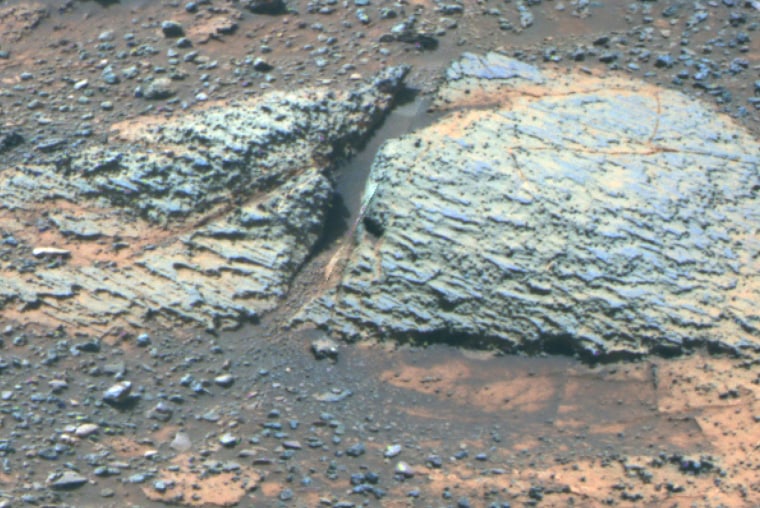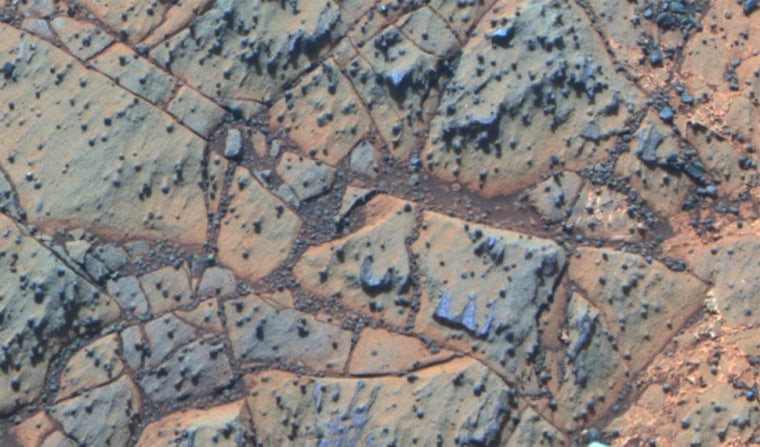
Ten years after it landed on Mars, NASA's Opportunity rover has hit pay dirt again: This time, the rover's scientists are reporting new evidence that garden-variety life could have thrived on the Red Planet billions of years ago.
Not long after Opportunity bounced to the surface in 2004, the six-wheeled rover came across geological formations that were formed amid standing water, suggesting a sort of habitability on ancient Mars. But back then, the evidence indicated that the water was salty and highly acidic — making for an environment that would have been suitable only for the hardiest organisms on Earth.
Now scientists are fleshing out a scenario that's more in tune with what NASA's Curiosity rover, a more recent arrival, found at a different site thousands of miles away. That suggests that life-friendly conditions could have existed for hundreds of millions of years.
"The punch line here is that the oldest rocks Opportunity has examined were formed under very mild conditions — conditions that would have been a much better niche for life, and also much better for the preservation of organic materials that would have been produced," said Ray Arvidson, a planetary scientist at Washington University in St. Louis.
Arvidson is the lead author of a research paper on the results, published in Friday's issue of the journal Science. The findings come from Opportunity's study of Matijevic Hill, an area on the rim of 14-mile-wide Endeavour Crater.

Clues seen from orbit
The six-wheeled rover has been surveying the crater's rim for more than two years, but readings provided by an instrument on NASA's Mars Reconnaissance Orbiter pointed to a rocky patch on Matijevic Hill as a potentially new frontier. The orbiter's CRISM instrument picked up hints of iron smectite, a type of clay mineral that's typically formed in the presence of water.
When Opportunity arrived on the scene, it ground into the rocks with its abrasion tool and analyzed their composition with its alpha particle X-ray spectrometer, or APXS. It also took a close look at berry-shaped spherules embedded in the rocks, plus fractures that were filled with calcium sulfate. All those lines of evidence pointed to a formation process that took place in the presence of neutral or mildly acidic water.
"The fractures had more water going through, and the conditions were mild," Arvidson told NBC News. "If I were back there in that period, and I wanted to make a well for my summer home, I would have driven it down into those fractures because it'd be drinkable water."
Curiosity found signs of similarly mild conditions in Gale Crater, not far from where it landed in August 2012. The site that Curiosity explored is thought to have been a water-filled lake as recently as 3.6 billion years ago. The rocks examined by Opportunity are significantly older than that, and certainly older than Endurance Crater itself — perhaps 4 billion years old. That suggests that areas of Mars could have been habitable over a span of several hundred million years.
"These mild aqueous conditions extended over a long period of time, and over an extensive area," Arvidson said. "Mars probably had a number of habitable environments, and then it went into this drying-out period, and the whole system went into the deep freeze."
Arvidson and his colleagues discussed some of their findings last year, based on their analysis of a rock on Matijevic Hill that was nicknamed Esperance. The Science paper fills out the picture with additional samples and geological context.
Questions remain
Opportunity can't run tests that are as detailed as the experiments that Curiosity can run, so it can't detect the kinds of organic chemicals that Curiosity can. But it can check out the surroundings and help scientists figure out more precisely how the ancient rocks were formed. Did they start out as volcanic ash deposits, or were they laid down as river sediments or lake sediments? Further investigation is likely to answer that question.
Arvidsen said he and his colleagues also want to continue their study of a strange rock that popped up in Opportunity's field of view this month and has been compared to a jelly doughnut. They're intrigued by the preliminary readings returned by the rover's instruments.
"We've never seen this composition before," Arvidson said. "It's high in sulfur, manganese, phosphorus, iron. ... It represents pretty substantial deposition of salts and oxides."
The findings about Mars' once-drinkable water and the jelly-doughnut rock demonstrate that Opportunity can still do useful science after 10 years, even though it has a gimpy wheel and an arthritic robotic arm. A decade ago, the rover science team anticipated having the rover in operation for only 90 days — so are they now starting to run out of things for Opportunity to do?
"Holy smokes, no," Arvidson said. "Not at all."
More about Opportunity and Spirit:
- Opportunity finds traces of drinkable water
- Spirit rover's legacy lives on 10 years after landing
- 10 years after launch, Opportunity hits milestone
Alan Boyle is NBCNews.com's science editor. Connect with the Cosmic Log community by "liking" the NBC News Science Facebook page, following @b0yle on Twitter and adding +Alan Boyle to your Google+ circles. You can also check out "The Case for Pluto," my book about the controversial dwarf planet and the search for new worlds.